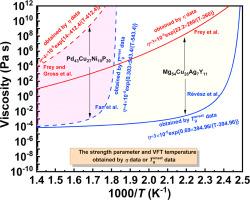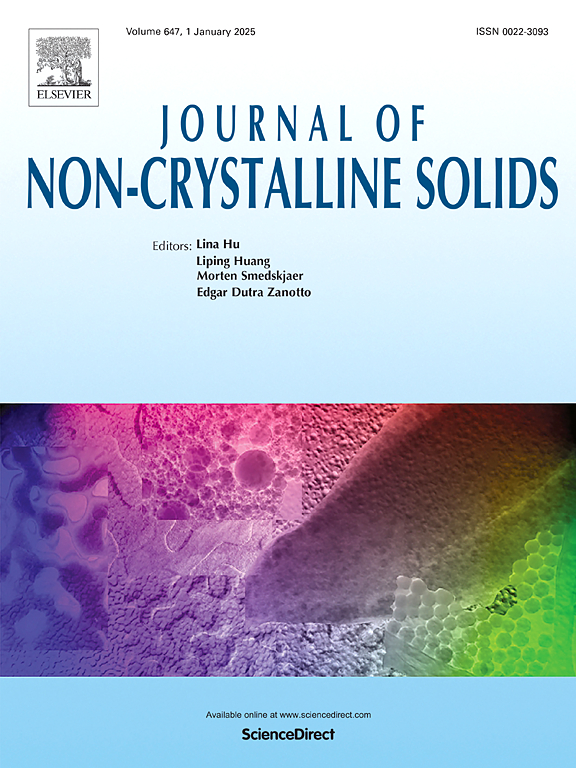非晶合金玻璃化转变的加热速率依赖所得到的黏度与实测黏度相符的条件
IF 3.5
3区 材料科学
Q1 MATERIALS SCIENCE, CERAMICS
引用次数: 0
摘要
研究了由玻璃化转变加热速率依赖得到的粘度ητ(T)与实测粘度η(T)吻合的条件。用Gη(T)/G0可以判断ητ(T)和η(T)的吻合程度,其中Gη(T)和G0分别为η(T)/τtrans(T)(跃迁时间)和η0/τtrans (T)(指数前因子)。当η(T)/G0 = 1时,ητ(T)与η(T)在整个温度范围内一致;相反,当Gη(T)/G0不等于1时,ητ(T)将偏离η(T)。Gη(T)与G0的差值越大,η(T)的低估或高估程度也越大。由Tgonset(qH)方程的常数Aq得到的理想玻璃转变温度Tη 0和强度参数Dq偏离Tgonset(qH)方程的常数Aq得到的粘度得到的理想玻璃转变温度Tη 0和强度参数Dq的原因过于小于常数(VGηΔTg)/NAh,其中NA、h、V、Gη和ΔTg分别是阿伏伽德罗常数、普朗克常数、摩尔体积、比例因子和玻璃化过渡区的宽度。本文章由计算机程序翻译,如有差异,请以英文原文为准。

The conditions of the coincidence between viscosity obtained by the heating rate dependence of glass transition and the measured viscosity for amorphous alloys
The conditions of the coincidence between viscosity ητ(T) obtained by the heating rate dependence of glass transition and the measured viscosity η(T) are studied. It is found that Gη(T)/G0 can be used to judge the degree of the coincidence between ητ(T) and η(T), where Gη(T) and G0 are η(T)/τtrans(T) (transition time) and η0/τtrans 0(the pre-exponential factor of η(T) and τtrans(T)), respectively. ητ(T) will be the same with η(T) in whole temperature range when Gη(T)/G0 equals 1; Conversely, ητ(T) will depart from η(T) when Gη(T)/G0 does not equal 1. The greater the difference between Gη(T) and G0 is, the greater the degree of underestimate or overestimate for η(T) is. The reason why ideal glass transition temperature Tg0 and strength parameter Dq obtained by Tgonset(qH) with three unrestricted fitting parameters depart from ideal glass transition temperature Tη 0 and strength parameter Dη obtained by viscosity results from the constant Aq of Tgonset(qH) equation is excessively less than the constant (VGηΔTg)/NAh, where NA, h, V, Gη and ΔTg are Avogadro’s constant, Planck’s constant, the molar volume, a scaling factor and the width of the glass transition region.
求助全文
通过发布文献求助,成功后即可免费获取论文全文。
去求助
来源期刊

Journal of Non-crystalline Solids
工程技术-材料科学:硅酸盐
CiteScore
6.50
自引率
11.40%
发文量
576
审稿时长
35 days
期刊介绍:
The Journal of Non-Crystalline Solids publishes review articles, research papers, and Letters to the Editor on amorphous and glassy materials, including inorganic, organic, polymeric, hybrid and metallic systems. Papers on partially glassy materials, such as glass-ceramics and glass-matrix composites, and papers involving the liquid state are also included in so far as the properties of the liquid are relevant for the formation of the solid.
In all cases the papers must demonstrate both novelty and importance to the field, by way of significant advances in understanding or application of non-crystalline solids; in the case of Letters, a compelling case must also be made for expedited handling.
 求助内容:
求助内容: 应助结果提醒方式:
应助结果提醒方式:


